When to Plant
Clematis can be planted as soon as the ground is workable. Clematis react to the seasons much like bulbs. In the summer and fall, there is vigorous root growth where energy is stored for next year’s growth. Come spring, clematis will produce two or three feet of top growth before any noticeable root activity. For this reason, in mild regions, fall planting is ideal. If planting in spring or summer, it is useful to periodically pinch out the growing tips.
If planting in the fall, pruning during the following spring is ideal, no matter which pruning group the clematis belongs to. Although this will inhibit flowering for the first year, it will help promote root development and produce a bushier plant.
If planting is done in the heat of the summer, it is essential that sufficient water is provided to keep roots moist and cool.
How to Plant
Be diligent in selecting a spot to plant: imagine where it will grow, and make sure your location provides sufficient light and a well-drained soil. There are clematis over eighty years old still blooming marvellously, thanks to well thought-out planting.
Clematis need a cool, moist, well drained, deep root run; with plenty of water. A little special preparation will ensure the proper environment. Dig a hole 18” deep by 18” wide [45cm x 45cm x 45cm]. Cover the bottom with a good rich compost or well-rotted manure. A handful of bone meal mixed with your soil is always a good idea. Add enough topsoil to cover the compost, and then you are ready to plant. Place your well-watered clematis in the hole so that about 6” [15cm] of stem is below the finished soil line. The stem of your clematis needs to be ripe before you bury it. If there is any concern about this, leave the final filling of the hole until later in the season. Be extra careful not let a clematis fall over or the stems can be easily become damaged. If the stems do become kinked, consider it only a minor setback as the stem might die but the plant will quickly recover. Securely attach the stems to a support so that they won’t blow over in the wind. Planting a small shrub in front will insure a cool root run for the clematis. If planting against a wall, a trellis should be constructed in such a way that it can be let down in one piece at house painting time.
Planting Clematis on a Fence or Trellis
Unless you are intending to use them as a ground cover, clematis need something to climb on. Sweet pea netting or plastic mesh work well.
- Carefully, but securely, attach the vine to a cane to lead the stem to a fence.
- Backfill with good quality top soil mixed with a handful of bone meal (if your soil has a high clay content, add peat moss).
- The top of the root ball should be at least 6” (15cm) below ground level.
- Top with 6” (15cm) of well-rotted manure mixed with good top soil or compost.
- Base of hole should contain good top soil.
- Where practical, it is a good idea to plant a small shrub to shade the roots of your clematis.
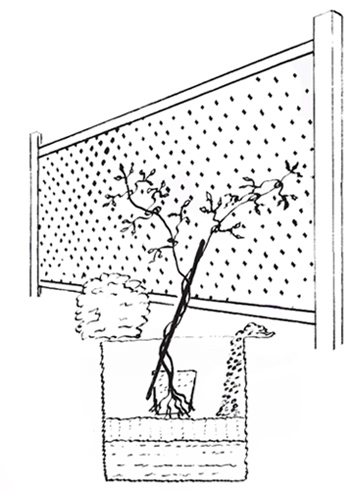
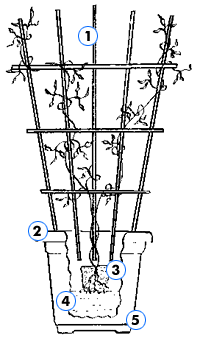
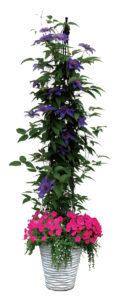
Planting Clematis in Containers
Most varieties of clematis will do well in containers, although their overall height may change due to the size of the container. In the variety descriptions starting on page 22, the symbol “©”designates varieties found to be best suited for containers. Special care must be given to choosing the right container, support, soil and of course, variety. Ideally, the minimum size of container should be 18” x 18” x 18” (45cm x 45cm x 45cm) In picking a container, metal or any material that conducts heat should be avoided. A potting soil with a high content of coarse peat moss will help retain moisture but also provide sufficient drainage.
Proper support is very important. If you are going to grow your clematis against a wall, a trellis of some sort is required. In lieu of a trellis, sweet pea netting stapled to a fence or wall serves as an inexpensive and effective support. If you wish to have your container free standing, a tripod of bamboo or cedar stakes works very well. Most garden centres will sell metal obelisks, like the one pictured here, which also make great free-standing supports. Many different trellises work equally well, so it really comes down to personal preference. If your container is large enough, annuals or a groundcover can be planted on the surface.
The size of the container and the amount of growth on your clematis will be important factors in determining frequency of irrigation. Water well when the soil is dry. Overwatering can cause unwanted results including: fungi, stunted growth or collapsed plants. Use a well-draining potting soil that will provide a neutral pH and good aeration. Ensure that your container has several drainage holes punched in the bottom for good drainage.
- The size of the container and the amount of growth on your clematis will be important factors in determining frequency of irrigation. Water well when the soil is dry. Overwatering can cause unwanted results including: fungi, stunted growth or collapsed plants.
- A tripod of strong canes or in this case a metal obelisk makes a good free standing support. Many different trellises work equally well.
- Use a well-draining potting soil that will provide a neutral pH and good aeration.
- Ensure that your container has several drainage holes punched in the bottom for good drainage.
Beautiful as Cut Flowers
Cut clematis flowers are growing in popularity. The wide range in size, color and shape of clematis flowers, makes their blooms an ideal foil for the florist. Blooms picked just as they are opening can last up to three weeks in a vase with a preservative. Without preservative, they typically last a week or two. Many varieties produce attractive fluffy seed heads that work well in dried flower arrangements. Floating blooms in a bowl is another way of displaying these beautiful flowers. Florist-supplied cut clematis have been used in arrangements in many prominent locations including the White House.
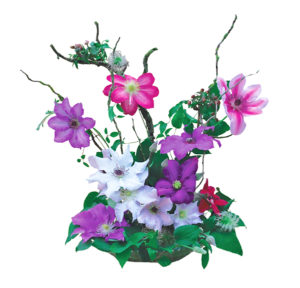
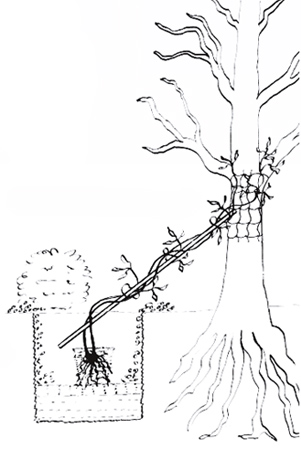
Planting to grow through a Tree
If it is not practical to plant away from the base of the tree, consider planting in a large bottomless container right at the base of the tree, following the information provided in the “Planting in Containers”.
Clematis need something to climb on. Sweet pea netting or plastic mesh work well. Carefully but securely attach the vine to the supporting structure attached to the tree trunk.
Many varieties of clematis can climb high into a tree and throughout its canopy of branches. Non-flowering trees become adorned with large colourful blossoms from the clematis planted at the base of the tree. If you are planning on growing clematis up a large tree, the most vigorous and largest growing varieties are the montanas, which can grow 50 feet or higher. Many other varieties, such as Jackmanii, can surpass 30 feet and can also work well. For temperate areas, C. armandii can also work very well. More compact varieties such as The President are suitable for smaller trees such as Japanese Maples. If possible, plant outside the drip line of the host tree

